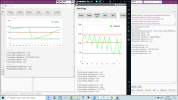Hi, All
If to have a chart, i mean, the data table with 2 columns, say weather temperature per hour - it would be good to have an analysis code that can check the data changing trend and return some result.
Say, "Temperature is rising during 5 hours", or "Warning: sudden freeze for -20 degrees during 5 hours !" ...
Any ready lib or code module for such analysis ?
If to have a chart, i mean, the data table with 2 columns, say weather temperature per hour - it would be good to have an analysis code that can check the data changing trend and return some result.
Say, "Temperature is rising during 5 hours", or "Warning: sudden freeze for -20 degrees during 5 hours !" ...
Any ready lib or code module for such analysis ?

